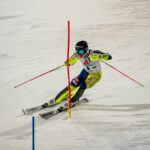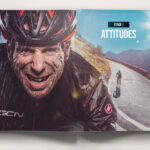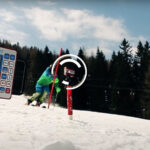Over the past six weeks I’ve worked on- and off-snow with a handful of top juniors individually and four of the leading junior programs in the U.S. As usual, I learned things in my work with the athletes and coaches that always remind me of what I would call the “little big things” in ski racing. These issues appear rather small on the surface, yet can make a huge difference in your skiing.
Each topic wasn’t quite big enough to devote an entire article to, but they all deserved some attention. So, I’ve decided to group them into this one article because each has pretty significant power to help improve your skiing and, used together, can have a really positive impact on your skiing throughout the long race season.
Free Skiing isn’t Free
I hate the words “free skiing.” They are inaccurate and misleading. These words suggest that when you’re not running gates, it doesn’t matter what you do. I see this with a lot of racers. When they’re running gates, they are focused and intense, but when they’re free skiing, they’re often not doing anything to make themselves a better skier.
The fact is free skiing is anything but free. It will cost you or you will profit from it. Free skiing should be called “gateless training.” It is the time when most fundamental technical work is done. Only after you are able to do something technically while gateless training will you be able to do it in gates. So gateless training should have the same level of purpose, focus, intensity, and effort that you put into your gate training.
Gateless training is so important because every turn you make counts. Becoming the best ski racer you can be is about repetition. You have to make thousands upon thousands of turns before you ingrain a new skill. But repetition alone isn’t enough. You have to have quality repetition. If you don’t here’s what will happen. You’re going to make a run of 40 turns. Since you’re free skiing rather than gateless training, you only maintain good quality for the first 20 turns. So you made 20 good turns and 20 bad turns. Did you improve that run? Absolutely not! The 20 bad turns erased any benefit you may have gotten from the 20 good turns.
You must make sure that every turn you make is of the highest quality. Okay, so every turn may be unrealistic. But if you make 90% good turns, you’re way ahead of the game. To have quality repetition, you must have clear purpose, 100% focus and intensity, and give your best effort every turn.
Quote of the Day: “I started to free ski more consciously, controlling all of my movements. I set imaginary gates in front of myself. I tried to feel all of the movements during free skiing.” March Girardelli
Maximize The Value Of Video
Watching videos of yourself and top racers is a valuable tool for improving technique and increasing motivation, confidence, and focus. Video enables you to more clearly see and understand what you need to work on and proper technique and tactics demonstrated by world-class racers. Video, as a form of external race imagery, also helps you generate the image and feeling of skiing your best.
But you may not be watching video in the most effective way. You may watch only your mistakes in the belief that this will help you correct it. But this approach ingrains a negative image into your mind. You may focus too much on details of the video, for example, hand position, rather than on the whole image. Watching too much World Cup video and not enough of yourself may cause you to imagine yourself skiing like one of them rather than the way you ski. And the absolutely worst thing to do is watch videos of your peers!
When you watch video follow these rules. Take in the whole image rather than paying too much attention to details. Allow the image of good skiing sink into your mind. Though you learn about what you need to work on by watching your mistakes, I recommend watching at least 75% “highlight” videos of yourself skiing well. Watching World Cup racers is valuable, but rather than imagining yourself skiing like them, include their good technique into how you actually ski. To maximize this benefit, when you watch World Cup footage, identify racers who are physically and technically similar to you so you can more easily incorporate good technique into your style.
You can enhance the value of video by using mental imagery as part of a video session. After watching yourself make a mistake on video, “edit” the video in your mind and replay the run with race imagery, seeing and feeling yourself skiing better. After a “highlight” run on video, replay the run with race imagery to ingrain the positive image and feeling.
On-Snow Mental Imagery
In addition to the off-snow mental imagery program I have described in a previous article as the most important mental tool you can use, some of the most effective use of imagery can be done on the hill during gate training. Incorporating mental imagery into your on-snow preparation will enhance the quality of the training and accelerate your improvement.
Mental imagery is useful at three phases of gate training. First, typically after you have been given feedback from your coaches following a training run, you will say you understand and head to the lift for your ride up for your next training run. How well the instruction sinks in questionable. To ensure that you really get the feedback, close your eyes and imagine yourself doing the technical or tactical change your coaches want. This practice serves two purposes. It increases the likelihood that they will remember the instruction. Also, since visual information transfers to the muscles better than verbal information, the imagery will enhance the learning of the skill. Additionally, if you have a good training run, you should mentally review the run so you remember the image and feelings associated with it.
Second, you spend more time riding lifts than skiing. That time on the lift is usually spent talking, i.e., wasting time. Instead, use the lift ride to increase the quality of your training. On the ride up, close your eyes and imagine yourself on the next training run doing the new skill. This will further ingrain your coaches’ feedback and facilitate the learning process.
Third, use imagery just prior to your next training run. Before leaving the gate, briefly imagine what you want to work on that run. This further ingrains the new skill and establishes a clear focus for the run.
Point A To Point B
The start and finish of a training course are the essential parts of training. Yet, the start and finish are also the most neglected parts of training. A course can be thought of as Point A (the starting gate) to Point B (the finish line). Since the clock starts at Point A and finishes at Point B, it is important that you learn to ski your best from Point A to Point B.
I often see racers have weak starts or take several gates to settle into the training course and establish their rhythm before they start skiing hard. In effect, they haven’t started racing the course even though they have left the starting gate. By doing this, they are developing the habit of easing into a course, so on race day, that is what will come out. Since the race clock starts as soon as you trip the wand, this approach will cause you to be behind at the first gate and you will be playing catch up the rest of the course.
I encourage coaches to always have a starting gate set up for training courses and ideally a wand should be used as well. If there is no starting gate, pretend there is one. Train yourself to go 100% from the start. Have a strong start and attack the first gate with abandon. Then continue this “attacking attitude” for the remainder of the course.
Another annoying habit I see with young racers is to ease up a gate or two before the finish. Also, coaches often don’t even set a finish gate. This too creates a bad habit of letting up before Point B when the clock stops. This can cause you to lose focus and intensity before the training course or race is over. In fact, it is quite common for racers to make a mistake, like hook a tip, a few gates from the finish because they stop focusing.
Coaches should always set a finish gate in training. Be sure you go all out and maintain the attacking attitude through the finish line. Experiment with ways of finishing the course fast, for example, skating or tucking. During training, always think in terms of Point A to Point B, going all out and not letting up from start to finish.






